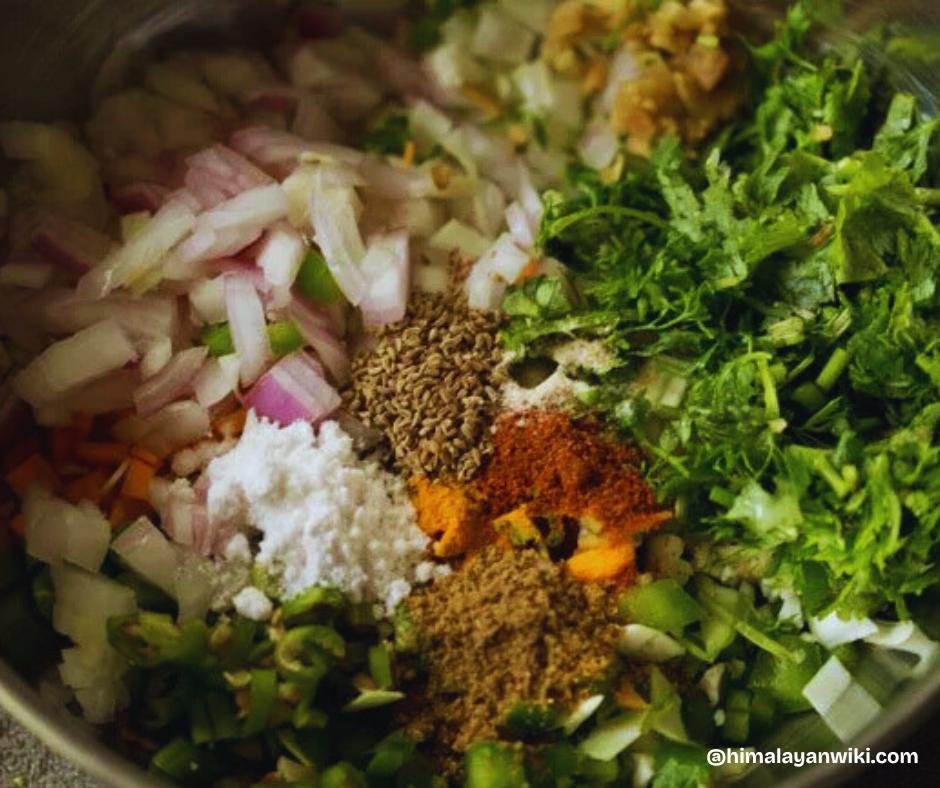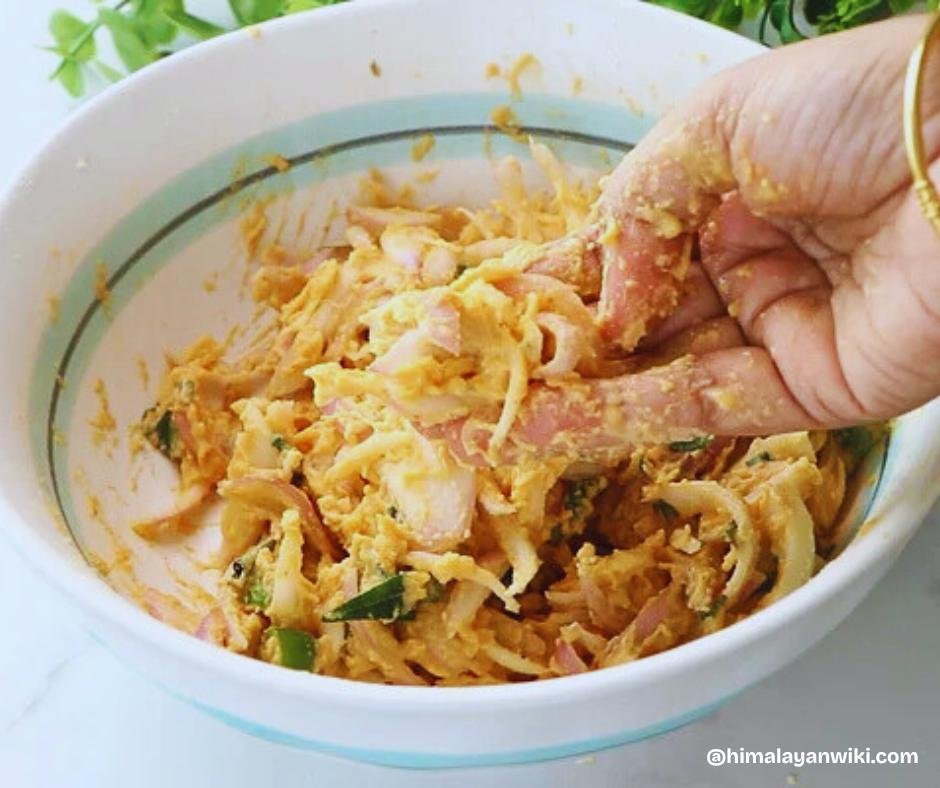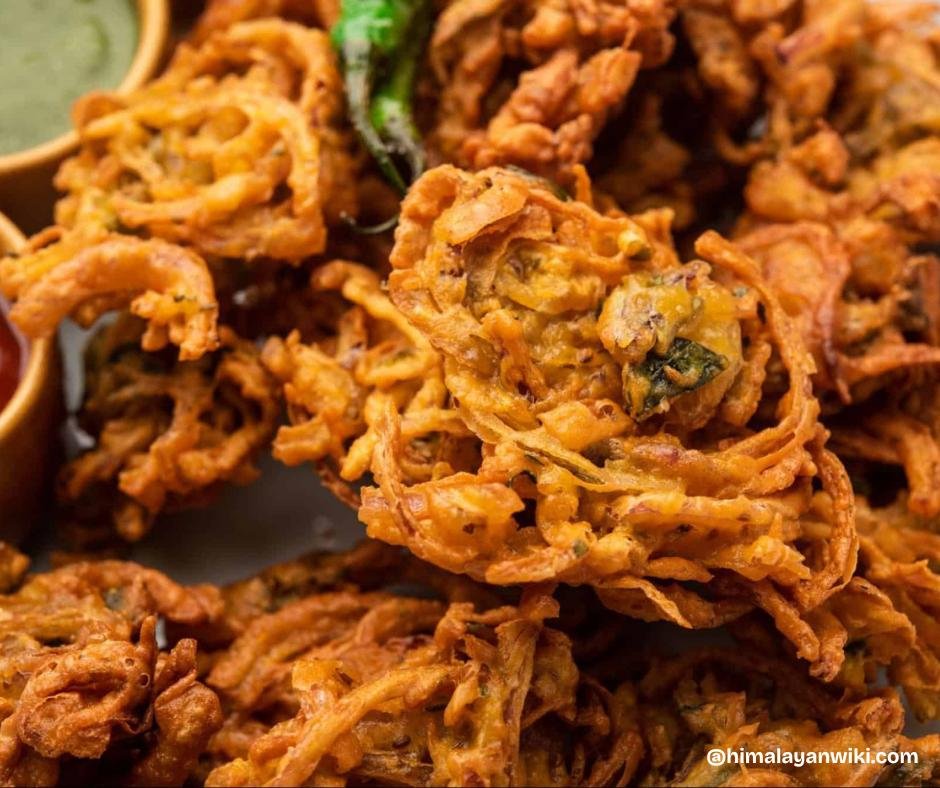Pakora is one of the most popular Indian, Pakistani, and Nepalese dishes, which is made from gram flour, spices, and vegetables like potatoes and onions. It is a kind of fritter that is deep-fried until it becomes golden brown.
✓ Pakoras are often served as snacks, but they can also be a main dish. There are multiple variations of pakora, but the most common elements include onions, potatoes, green chillies, and cilantro. Other popular vegetables include cauliflower, carrots, and cabbage. It can also be assembled with seafood, like shrimp or fish.
✓ The pakora is also known under other spellings, including pikora, pakoda, pakodi, and provincial names like bhaji, bhajia, bora, ponako, and chop. The herbs used in pakora differ depending on the region, which is spiced with turmeric, cumin, coriander, garam masala, and chilli powder.
✓ Some recipes also call for ajwain seeds, which give the pakoras a negligibly nutty flavour. To cook pakoras, the vegetables are first diced and combined with the batter. The batter is created by mixing gram flour, water, and spices. The batter should be viscous enough to cover the vegetables, but not too viscous because it is difficult to work with.
| Read More: Nepal Wildlife |
Etymology
✓ The word pakora emanates from the Sanskrit pakvavata, a combination of pakva and vata or its derivative vataka, a spheroidal cake made of vibration fried in oil or ghee. The word Bhajji emanates from the Sanskrit word Bharjita, which means fried.
✓ The word “pakora” is also encountered in the Tamil vocabulary, where it is spelt “pakoda.” Some variation of adaptation may be recorded in the third consonant in the word. The sound is a tough ‘da’ in the Telugu language, and the ‘ra’ sound will be an inaccurate articulation, which is the retroflex flap, which is registered in Hindi.
History
✓ The history of pakora is a lengthy and storied one, which is believed to have been originated in India, where it has been appreciated for centuries. In the 11th century, the first recorded mention of pakora occurs in the Sanskrit reader Manasollasa. The text describes a dish called “Parika,” which was served as part of the repasts.
✓ In the 19th century, pakora was submitted to the West by Indian expatriates, which quickly became popular, and today it is a staple of Indian restaurants all over the world.
✓ Before-known recipes come from the Manasollasa cookbook, which says “Parika” and the steps of designing it with vegetables and gram flour. The Lokopakara cookbook also brings a special pakora recipe where gram flour is squeezed into fish-shaped decays and fried in mustard oil.
Types of the best Pakora
Here are the best types of Pakora:
1. Onion Pakora
If only onion is used as a veggie ingredient while making pakora, it is known as onion pakora.
2. Potato Pakora
If only potato is used as a veggie ingredient while making pakora, it is known as potato pakora.
3. Cabbage Pakora
If only cabbage is used as a veggie ingredient when making pakora, it is known as cabbage pakora.
4. Carrot Pakora
If only carrot is used as a veggie ingredient while making pakora, it is known as carrot pakora.
5. Fish Pakora
If only fish is used as an ingredient when making pakora, it is known as fish pakora.
6. Chicken Pakora
If only chicken is used as an ingredient when making pakora, it is known as chicken pakora.
7. Egg Pakora
If only boiled egg is used as an ingredient when making pakora, it is considered egg pakora.
About Vegetable Pakora
Vegetable Pakora is a type of pakora that is created by combining several kinds of vegetables like cauliflower, carrot, bell pepper, cabbage, broccoli, brinjal, spices, herbs, and gram flour.
It is a popular snack and street food in several countries that contains high fibre which is very beneficial for our health. To make Pakora, you can decide to add any veggies such as steamed/boiled corn, finely chopped potatoes or sweet potato, chopped broccoli, spring onions, and grated beetroot.
Ingredients to make vegetable Pakora

| Ingredients | Quantity |
| Rice flour | 1/4 cup |
| Gram flour (besan) | 1/2 cup |
| Water | 1/2 cup |
| Turmeric powder | 1 teaspoon |
| Cumin powder | 1 teaspoon |
| Coriander powder | 1 teaspoon |
| Garam masala powder | 1/2 teaspoon |
| salt | 1/2 teaspoon |
| chopped onion | 1/4 cup |
| chopped green chillies | 1/2 cup |
| chopped cilantro | 1/4 cup |
| Vegetable oil, for deep-frying | as required |
| Chili powder | 1/4 teaspoon |
How to make Vegetable Pakora?
Preparation

✓ First, you should prepare all the vegetables by washing and rinsing them. Then, finely slice the onion, bell pepper, potato, and carrot into approximate pieces; you can also grind them.
✓ You can also use additional veggies like cauliflower, broccoli, and brinjal, which are almost the same size and may be thin or long, which helps you in the frying process.
✓ You should stuff the vegetables release to remove the dampness that then vegetable release and put them all in a mixing bowl.
Scatter the Flour

✓ Secondly, you must scatter the rice flour over the veggies and toss the bowl and try to cook the veggies fast.
✓ Then, you should mix the 1/2 cup chopped green chillies and 1/2 teaspoon salt and other ingredients and provoke fast. Observed the gram flour, stir the vegetables until all are covered with the flour and put the water little by little as you keep combining.
✓ You should blend everything well to make a dough and set aside that mixture for about 10 minutes.
Prepare a Dough

✓ You shouldn’t need to utilise all the water offered in this recipe. What you want is for the flour to coat the vegetables rather thickly but not swelteringly. And you should make sure the batter is not watery.
✓ If you feel like there are fewer ingredients you can easily require as u required therefore you should taste it at once.
Fry the pakora

✓ Now, you should heat the oil to medium-high heat in a deep frying pan. You can try and test the oil by dropping a slight drop of the batter, which characterises the temperature.
✓ You should fry it at a constant speed and not too quickly. Then carefully glide the vegetable mixture in the oil a spoon at a time. And make sure there is enough space between one another.
Ready to eat

✓ You must fry for 2-3 minutes on each flank, or until golden brown and crispy.
✓ At last, you should drain the pakoras on paper towels and can serve it when hot with chutney or sauce.
Recipe Note
Here are some tips:
✓ You should utilise good-quality gram flour for the most profitable results.
✓ You shouldn’t overmix the batter, or the pakoras will be challenging to cook.
✓ You should make sure that the oil is hot and alluring before counting the pakoras, or they will soak too much oil and become slippery.
✓ You shouldn’t overcrowd the frying pan when frying the pakoras, or they will not cook evenly.
✓ You must drain the pakoras on paper towels instantly after frying to release extra oil.
✓ You can serve it hot with your favourite chutney or sauce at any function or as a snack.


